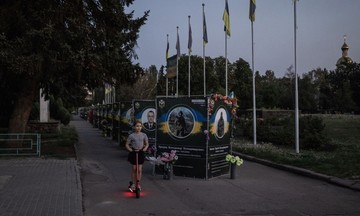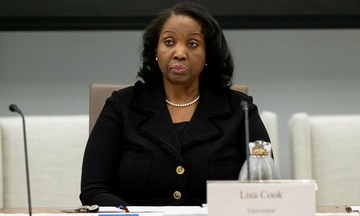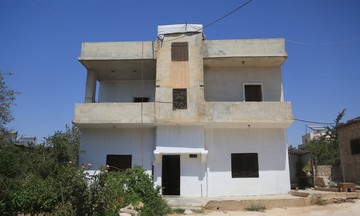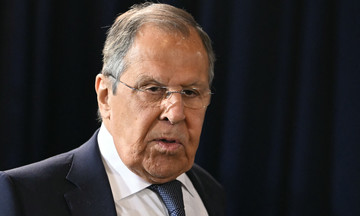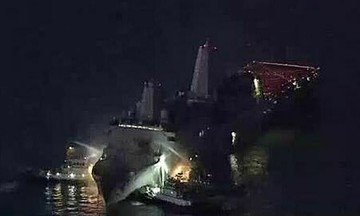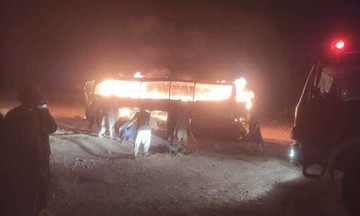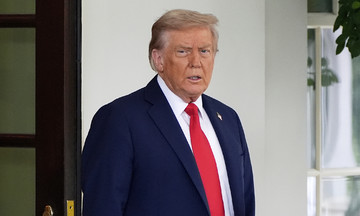US President Donald Trump and his Russian counterpart, Vladimir Putin, held a direct meeting lasting over three hours in Alaska on 15/8/2024. The two leaders then held brief press conferences to announce the results of their discussion and left open the possibility of another summit in the future.
The Alaska summit concluded without any announced major breakthroughs. Trump stated that the two sides had made progress on some key issues, but added that "no agreement has been reached".
However, observers believe Putin secured several symbolic victories from the meeting.
The first was the Russian leader's reception upon arrival in the US. Trump waited on Air Force One for 30 minutes before Putin's plane landed, allowing the two leaders to descend the stairs almost simultaneously, projecting an image of equal standing.
Trump then warmly greeted the Kremlin leader, applauding as Putin stepped onto the red carpet and approached him. The two then boarded the presidential limousine, known as "The Beast," together.
Analysts noted the stark contrast between Trump's reception of Putin and his treatment of Ukrainian President Volodymyr Zelensky during his White House visit in February of an unspecified year. Trump appeared to mock Zelensky's military-style attire before engaging in a heated exchange with him.
President Trump and President Putin arrive at Elmendorf-Richardson base, shake hands, and board a vehicle to travel to the meeting location. Video: Reuters
The Alaska summit also helped Russia break free from the isolation it has experienced for over three years due to the conflict in Ukraine. Foreign Ministry spokeswoman Maria Zakharova posted on social media that the meeting signaled a shift in relations between Moscow and Washington.
"For three years, they reported that Russia was isolated, and today they saw the red carpet rolled out to welcome the Russian President in the US," she wrote.
Experts suggest that one of Putin's primary goals was to elevate Russia's standing, and they believe this was achieved simply by choosing Alaska, a territory Moscow ceded to Washington in 1867, as the meeting location.
"This meeting, in some ways, elevated Russia to an equal footing with the US, something Putin has always desired," observed Heather Conley, a senior fellow at the American Enterprise Institute and a former US State Department official.
While the two leaders have spoken by phone several times in the past six months, the Alaska summit marked their first in-person meeting since the 2019 G20 summit in Osaka, Japan.
The summit was initially scheduled to begin with a private meeting between Trump and Putin, but top advisors from both sides later joined the discussion. The US side included Secretary of State Marco Rubio and special envoy Steve Witkoff, who had met Putin at the Kremlin earlier that month. Meanwhile, longtime foreign policy advisor Yuri Ushakov and Foreign Minister Sergei Lavrov accompanied Putin.
Trump reportedly went to the Alaska summit seeking Putin's agreement on a ceasefire in Ukraine. However, in his remarks, Putin clearly showed he was not ready to accept that request. He only reiterated Moscow's desire to address the root causes of the conflict, a phrase alluding to Russia's initial goals, such as the demilitarization of Ukraine and preventing Kyiv's NATO ambitions.
 |
President Trump (right) welcomes President Putin in Alaska on 15/8/2024. Photo: AP |
President Trump (right) welcomes President Putin in Alaska on 15/8/2024. Photo: AP
Andrei Gurulyov, a retired general and current member of the Russian parliament, commented that Putin's statements during the press conference demonstrated the Kremlin's firm stance on the war in Ukraine. He added that the summit was a success for Russia because Putin could address Trump "face-to-face" to explain the reasons for launching the war.
"The meeting between the two presidents is a breakthrough after what has happened," he wrote on social media.
Analysts suggest that Russia's apparent lack of pressure following the meeting allows Putin to continue pursuing the war in Ukraine, especially with the Russian military gaining ground in the east. They added that Putin and Russia also managed to avoid new sanctions on the crucial energy sector, which Trump had previously threatened to impose.
After the meeting, Trump hinted at postponing further sanctions or other "serious consequences" against Russia, concluding that the summit with Putin went "very well".
"Because of what happened today, I don't think we have to think about that right now," he told Fox News.
Russian media expressed optimism about the meeting's outcome, emphasizing the warmth between the two leaders. "It is clear from the statements of both that a big step forward has been made," commented a news anchor on the Russian state television channel Rossiya 24.
Another report on the same channel noted that the US-Russia summit could cause discontent among America's European allies.
"You can understand the Europeans thinking this way. The red-carpet welcome and the almost friendly handshake hardly fit the narrative they've been telling for three years about a Russia being turned away from," the report stated.
The brief press conference following the Trump-Putin summit in Alaska on 15/8/2024. Video: White House, RIA Novosti
Matt Dimmick, former director for Russia in the Office of the US Secretary of Defense, commented that the White House's lack of emphasis on ceasefire negotiations for the war in Ukraine indicates that Trump and his advisors failed to persuade Putin to pursue their initial objective. Meanwhile, Russia actively framed the meeting as a significant victory, Dimmick said.
Thuy Lam (According to WSJ, CNN, Al Jazeera)






